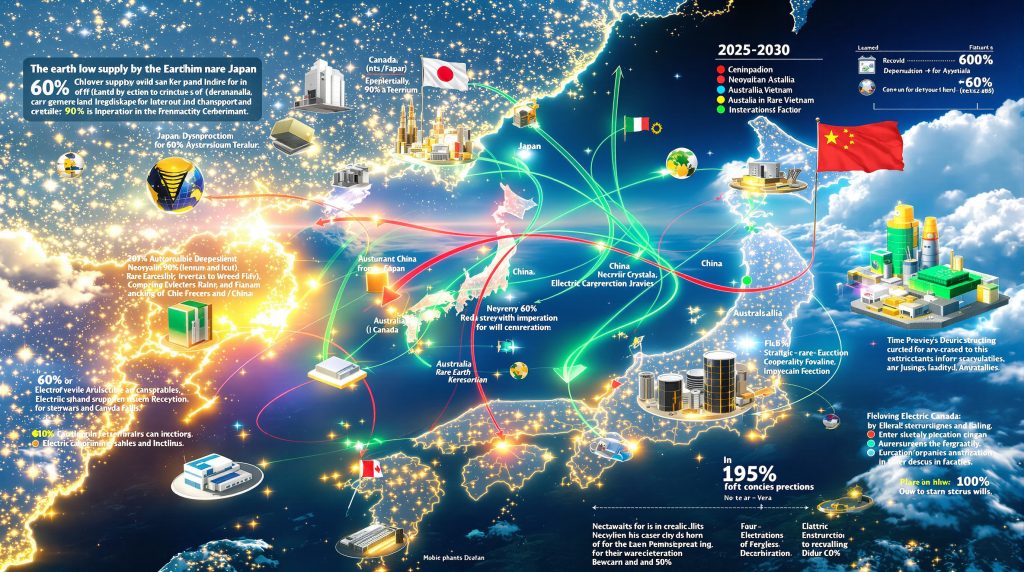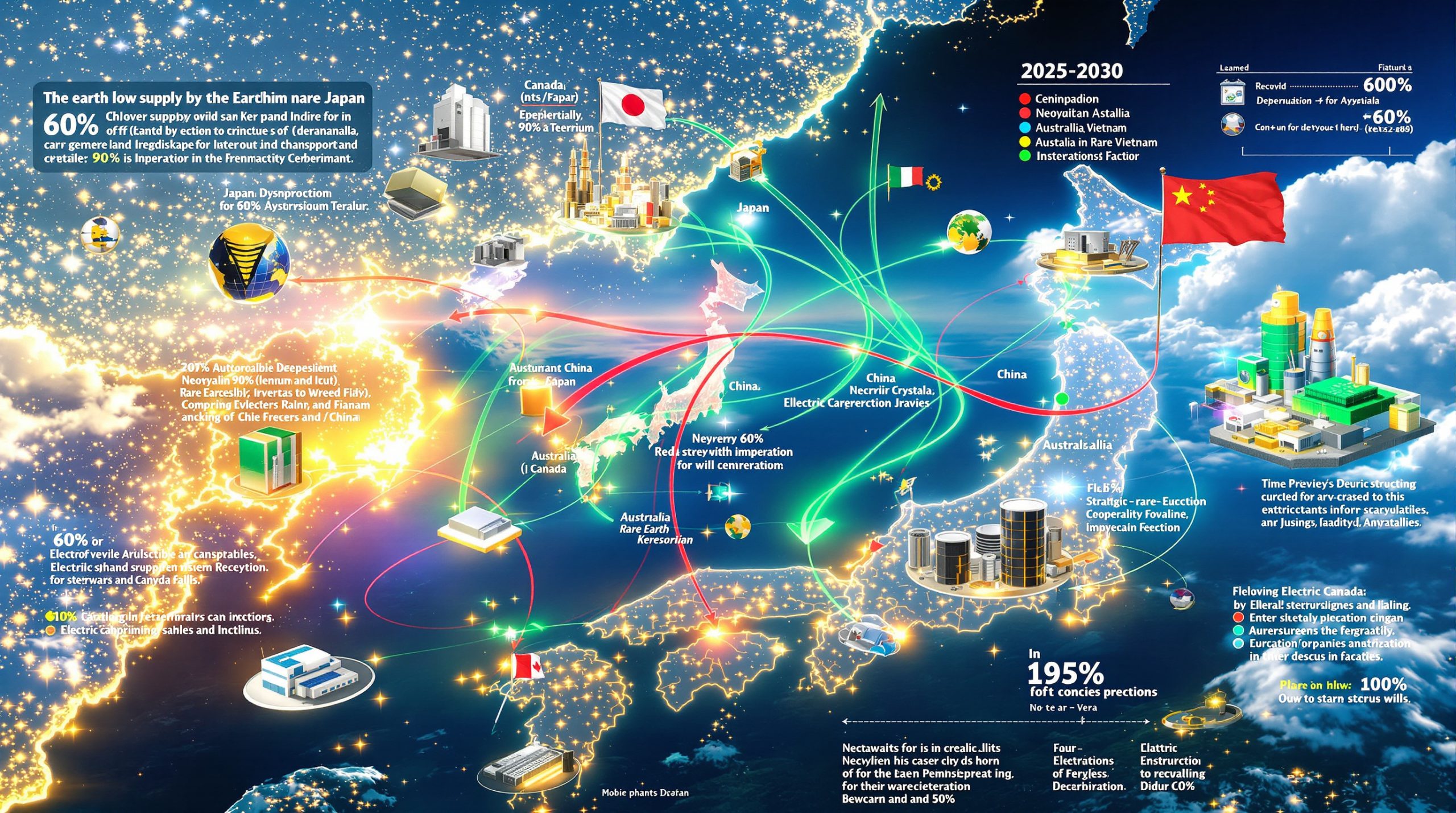Critical Mineral Dependencies and Strategic Vulnerabilities
The global economy's reliance on rare earth elements has created unprecedented strategic vulnerabilities that extend far beyond traditional commodity markets. These seventeen metallic elements, essential for everything from smartphone batteries to wind turbine magnets, represent a unique intersection of geological scarcity, technological necessity, and geopolitical leverage. As nations increasingly recognise the strategic implications of mineral dependencies, the relationship between energy transition security and national competitiveness has fundamentally transformed how countries approach resource diplomacy.
Understanding this transformation requires examining how export control mechanisms have evolved from simple trade restrictions into sophisticated tools of economic statecraft, particularly in the context of Japan China rare earth export controls that continue reshaping regional supply chain dynamics.
Understanding Modern Rare Earth Export Control Architecture
Export control systems governing rare earth minerals have undergone significant structural changes since the early 2000s, moving beyond traditional quota-based restrictions toward more sophisticated regulatory frameworks. Contemporary control mechanisms operate through multiple enforcement layers, incorporating production licensing, refining permits, and distribution authorisations that create complex approval pathways for international buyers.
The evolution from reactive trade barriers to proactive supply chain governance represents a fundamental shift in how resource-rich nations exercise economic influence. Modern export control systems integrate seamlessly with broader technology transfer restrictions, creating interconnected regulatory networks that affect everything from raw material extraction to advanced manufacturing equipment sales.
Furthermore, provincial-level enforcement mechanisms have expanded substantially in recent years, with local authorities gaining increased discretionary power over export licensing decisions. This decentralised approach allows for more nuanced control over supply flows while maintaining flexibility in responding to changing geopolitical circumstances.
Regulatory Framework Complexity
Contemporary export control systems operate through sophisticated case-by-case approval processes that evaluate multiple factors including end-user applications, strategic importance, and bilateral diplomatic relationships. These approval mechanisms have evolved far beyond simple administrative procedures, incorporating detailed supply chain auditing requirements and long-term monitoring obligations.
The extraterritorial reach of modern export controls affects global manufacturing chains through secondary restriction clauses and re-export licensing requirements. Companies utilising controlled materials in their manufacturing processes often face ongoing compliance obligations that extend throughout the product lifecycle, creating complex legal frameworks that influence strategic business decisions.
Japan's Supply Chain Resilience Transformation
Japan's approach to managing rare earth vulnerabilities demonstrates how advanced economies can systematically reduce strategic dependencies through diversified sourcing strategies and technological innovation. The country's experience illustrates both the challenges and opportunities inherent in rebuilding supply chain architecture for critical materials.
Supply source diversification efforts have focused on developing partnerships with alternative producing regions, including significant investments in Australian rare earth processing capabilities and strategic relationships with emerging African producers. These initiatives represent long-term commitments that extend beyond simple purchase agreements to include technology sharing, infrastructure development, and joint venture arrangements.
Alternative Sourcing Strategies
Japanese companies have pursued comprehensive supply chain restructuring through multiple parallel approaches:
-
Partnership Development: Long-term agreements with Canadian and Vietnamese processing facilities that provide guaranteed supply allocations while sharing technological expertise
-
Infrastructure Investment: Direct financing of extraction and refining capabilities in partner countries, creating dedicated supply channels independent of traditional market mechanisms
-
Recycling Innovation: Advanced battery recycling innovation programs that recover rare earth elements from electronic waste streams, potentially providing 10-15% of domestic consumption requirements
-
Strategic Stockpiling: Government-coordinated reserve systems that provide 6-12 month supply buffers for critical manufacturing sectors
The effectiveness of these strategies depends heavily on sustained political commitment and continued technological advancement in processing efficiency. Early results suggest significant potential for reducing import dependencies, though complete supply chain independence remains a long-term objective requiring decades of consistent investment.
Consumption Optimisation Achievements
Japanese manufacturers have demonstrated remarkable progress in reducing overall rare earth consumption through advanced materials research and process optimisation. Industry reports indicate substantial reductions in per-unit rare earth requirements across multiple sectors, achieved through improved magnet designs, alternative material substitutions, and enhanced manufacturing efficiency.
These consumption reductions represent genuine technological breakthroughs rather than simple production cuts, maintaining or improving product performance while using fewer critical materials. Consequently, the automotive sector has shown particular innovation in developing high-performance electric motors that require significantly reduced rare earth inputs compared to earlier generation designs.
Geopolitical Dimensions of Resource Security
The strategic importance of rare earth elements extends far beyond their immediate commercial applications, fundamentally influencing defence capabilities, technological innovation, and economic competitiveness across multiple sectors. Understanding these broader implications requires examining how mineral dependencies intersect with national security priorities and international alliance structures.
Critical technology sectors demonstrate varying degrees of rare earth dependency, with semiconductor manufacturing, renewable energy systems, and advanced defence applications showing particularly high vulnerability to supply disruptions. These dependencies create cascading risks that can affect entire industrial ecosystems, making supply chain security a matter of national strategic priority, particularly evident in the current supply chain crisis.
Technology Competition Dynamics
Rare earth elements play essential roles in cutting-edge technologies that define competitive advantages in global markets:
-
Semiconductor Manufacturing: High-purity rare earth compounds enable advanced chip fabrication processes, with supply disruptions potentially affecting global electronics production timelines
-
Renewable Energy Infrastructure: Wind turbine generators and solar panel systems require substantial rare earth inputs, making clean energy transitions vulnerable to supply chain disruptions
-
Electric Vehicle Production: Battery technologies and electric motor systems depend on specific rare earth elements, with shortages potentially constraining automotive industry transformation
-
Defence Applications: Advanced military systems require rare earth elements for guidance systems, communications equipment, and electronic warfare capabilities
The concentration of rare earth processing capabilities in single geographic regions creates systemic risks that extend beyond individual company supply chains, affecting entire industrial sectors and national technological capabilities.
Regional Security Alliance Development
Multilateral partnerships focusing on critical mineral security have emerged as key mechanisms for reducing individual country vulnerabilities while strengthening collective bargaining power in global markets. These alliances combine diplomatic cooperation with concrete infrastructure investments and technology sharing agreements.
The Quadrilateral Security Dialogue framework has initiated discussions regarding coordinated approaches to rare earth supply chain development, including potential joint processing facility investments and shared strategic reserve coordination mechanisms. While specific implementation details remain under development, these initiatives represent significant steps toward reducing collective dependencies on single-source suppliers.
Moreover, regional cooperation extends beyond government-to-government agreements to include private sector coordination mechanisms that facilitate information sharing about supply chain vulnerabilities and collaborative responses to potential disruptions.
Industry-Specific Impact Assessment
Different industrial sectors face varying degrees of exposure to rare earth supply chain disruptions, with impact severity depending on material intensity, substitution possibilities, and strategic importance. Comprehensive risk assessment requires examining sector-specific vulnerabilities alongside broader economic implications.
Automotive Manufacturing Vulnerabilities
The automotive industry's transition toward electrification has created unprecedented demand for rare earth elements, particularly for high-performance permanent magnets used in electric vehicle motors. Current electric vehicle designs typically require 1-2 kilograms of rare earth materials per vehicle, with luxury and performance models often requiring substantially higher quantities.
Battery technology dependencies vary significantly based on chemistry choices, with some lithium-ion formulations requiring minimal rare earth inputs while others depend heavily on specific elements for optimal performance. Manufacturers face complex trade-offs between performance characteristics, cost considerations, and supply chain security when selecting battery technologies.
Production timeline vulnerabilities emerge from the extended lead times required for rare earth procurement and processing, with supply disruptions potentially affecting manufacturing schedules for 6-18 months depending on inventory levels and alternative sourcing capabilities.
Electronics and Semiconductor Sector Challenges
High-performance electronics manufacturing requires ultra-pure rare earth compounds that meet stringent quality specifications, creating additional supply chain complexities beyond simple material availability. The semiconductor industry's demanding purity requirements limit the number of qualified suppliers, increasing vulnerability to single-source dependencies.
Research and development constraints emerge when supply uncertainties discourage long-term technology investments that depend on reliable rare earth access. Companies may delay or abandon promising innovations due to concerns about future material availability, potentially slowing technological progress across entire industry sectors.
For instance, market competitiveness factors include the potential for supply cost volatility to affect product pricing strategies and profit margins, with companies facing difficult decisions about absorbing cost increases versus passing them along to consumers.
Strategic Risk Management and Scenario Planning
Comprehensive risk management for rare earth supply chains requires sophisticated scenario planning that accounts for multiple potential disruption pathways and their cascading effects across interconnected industrial systems. Effective planning must balance immediate operational needs with long-term strategic objectives while maintaining flexibility to respond to rapidly changing circumstances, particularly in light of recent developments in US-China trade strategies.
Disruption Scenario Analysis
Potential escalation pathways for supply chain disruptions include gradual tightening scenarios characterised by progressive licensing restrictions, increased administrative barriers, and selective technology transfer limitations. These gradual approaches allow affected parties time to develop alternative arrangements while maintaining plausible deniability regarding strategic intent.
More severe disruption scenarios involve targeted restrictions aimed at specific industries, companies, or end-use applications. Such targeted approaches can create maximum economic impact while minimising broader diplomatic consequences, making them particularly attractive policy tools for resource-rich nations seeking to exercise economic leverage.
However, complete supply cutoffs represent extreme scenarios that would likely trigger coordinated international responses and accelerated development of alternative supply chains. While potentially devastating in the short term, such dramatic actions often prove counterproductive in the long term by spurring rapid innovation and permanent market share losses.
Adaptive Response Strategies
Short-term tactical responses focus on immediate supply security through emergency stockpile expansion, alternative supplier acceleration, and intensified diplomatic engagement. These measures provide breathing room for implementing longer-term structural changes while maintaining operational continuity during transition periods.
Long-term strategic transformations require sustained investments in domestic processing capabilities, breakthrough materials research, and regional supply chain infrastructure development. These initiatives typically require 5-10 year implementation timeframes but offer potential for genuine supply chain independence.
Key adaptation priorities include:
-
Emergency Preparedness: Expanding strategic reserves to cover 12-18 months of critical consumption requirements across essential industries
-
Technology Development: Accelerating research into alternative materials and more efficient utilisation processes that reduce per-unit rare earth requirements
-
Partnership Building: Strengthening relationships with alternative supplier countries through infrastructure investments and long-term purchase agreements
-
Recycling Innovation: Developing commercially viable urban mining capabilities that can provide significant portions of domestic consumption needs
Policy Framework Evolution and Multilateral Cooperation
Effective responses to rare earth supply chain challenges require coordinated policy frameworks that integrate trade policy, industrial strategy, and international diplomacy while maintaining alignment with broader economic and security objectives. These frameworks must balance immediate crisis response capabilities with long-term strategic transformation goals, particularly considering recent policy developments like Trump's critical minerals order.
Critical Minerals Security Partnership Models
Successful multilateral approaches combine shared infrastructure investments with coordinated research and development initiatives that leverage collective expertise and financial resources. These partnerships create economies of scale that make alternative supply chain development more economically viable while distributing risks among multiple participants.
Joint processing facility development represents one promising approach, with participating nations contributing financing and expertise while sharing output allocations based on investment contributions. Such facilities can achieve technical specifications and cost efficiencies that individual national programmes might struggle to accomplish independently.
Furthermore, coordinated diplomatic responses enhance collective bargaining power in negotiations with supplier nations while providing mutual support for individual countries facing supply disruptions. These diplomatic coordination mechanisms can include information sharing protocols, joint démarche procedures, and aligned negotiating positions in international forums.
Balancing Economic and Security Objectives
Policy frameworks must carefully balance supply chain security improvements against potential economic costs and market efficiency losses. Excessive focus on supply security can lead to economically inefficient outcomes that undermine long-term competitiveness, while insufficient attention to security concerns creates dangerous vulnerabilities.
Integration of supply chain security considerations into broader trade policy requires sophisticated analytical capabilities that can assess complex interdependencies between economic and security factors. These assessments must account for dynamic changes in both security threats and economic conditions over extended time periods.
Investment incentives for domestic capabilities must be carefully designed to encourage genuine innovation and efficiency improvements rather than simply subsidising uncompetitive operations. Successful programmes typically combine financial support with performance requirements and sunset clauses that prevent permanent market distortions.
Future Market Dynamics and Strategic Implications
The rare earth market landscape faces fundamental transformation driven by technological innovation, changing geopolitical relationships, and evolving industrial requirements. Understanding these dynamics requires examining both supply-side developments and demand-side evolution across multiple sectors and geographic regions.
Technology Development Trajectories
Breakthrough materials research shows significant promise for reducing rare earth dependencies across multiple applications, with advances in permanent magnet alternatives, battery chemistry innovations, and semiconductor fabrication processes potentially reshaping demand patterns within the next decade.
Advanced recycling technologies offer potential for creating substantial secondary supply sources that could provide 15-30% of total rare earth consumption in developed economies. These urban mining capabilities depend on continued technology development and supportive regulatory frameworks that encourage collection and processing of electronic waste streams.
In addition, alternative supply chain infrastructure development accelerates as more countries recognise the strategic importance of processing capability diversification. New entrants into rare earth processing markets may fundamentally alter competitive dynamics and pricing structures over the next 5-10 years.
Market Structure Evolution
Price volatility patterns in rare earth markets reflect complex interactions between supply constraints, demand growth, and strategic stockpiling activities by major consuming nations. Understanding these patterns requires sophisticated analytical frameworks that account for both commercial and strategic market participants.
New producer countries entering global markets bring both opportunities and challenges, potentially providing alternative supply sources while creating new regulatory complexities and quality assurance requirements. The success of these new entrants depends heavily on their ability to achieve technical specifications and cost competitiveness with established suppliers.
Processing capacity distribution shifts toward more geographically diversified patterns could reduce systemic risks while potentially increasing overall costs during transition periods. These shifts require substantial capital investments and technical expertise transfers that may take years to fully implement.
Consequently, strategic alliance formation acceleration reflects growing recognition that individual nations cannot effectively address supply chain vulnerabilities through purely domestic approaches. These alliances combine resource sharing with risk distribution mechanisms that provide resilience benefits for all participants.
Navigating Supply Chain Transformation Challenges
The evolution of Japan China rare earth export controls represents a fundamental shift in how nations approach critical material security, requiring sophisticated responses that balance immediate economic interests with long-term strategic objectives. Success in this environment demands sustained investment in alternative supply chains, continuous technological innovation, and multilateral cooperation frameworks that reduce vulnerabilities while maintaining competitive advantages.
The path forward requires recognition that supply chain security and economic efficiency need not be mutually exclusive objectives. According to recent analysis from the International Energy Agency, carefully designed policies can enhance resilience while preserving the benefits of international trade and specialisation, creating more robust and sustainable industrial ecosystems.
However, as Japan's trade minister has indicated, "there has been no particular change in China's rare earth export controls," demonstrating the ongoing complexity of managing these critical supply relationships in an evolving geopolitical environment.
Disclaimer: This analysis is based on publicly available information and industry developments as of late 2024. Supply chain dynamics, government policies, and market conditions in the rare earth sector continue evolving rapidly. Readers should consult current official sources and expert analysis for the most up-to-date information on specific policy developments and market conditions.
Long-term success will depend on maintaining flexibility to adapt to changing circumstances while building systematic capabilities that provide genuine alternatives to existing supply chain dependencies. The countries and companies that best navigate these challenges will likely emerge with significant competitive advantages in the increasingly complex global economy.
Looking to Capitalise on Critical Minerals Market Volatility?
Discovery Alert's proprietary Discovery IQ model delivers real-time notifications on significant ASX mineral discoveries, including critical minerals essential for global supply chains and energy transition technologies. With supply chain disruptions creating unprecedented opportunities for discovery-rich companies, subscribers gain immediate access to actionable investment insights that could position them ahead of major market movements. Begin your 30-day free trial today and discover why historic mineral discoveries have generated substantial returns for early investors.




